Yong Liang Guan
DFT-s-OFDM with Chirp Modulation
Aug 06, 2025Abstract:In this paper, a new waveform called discrete Fourier transform spread orthogonal frequency division multiplexing with chirp modulation (DFT-s-OFDM-CM) is proposed for the next generation of wireless communications. The information bits are conveyed by not only Q-ary constellation symbols but also the starting frequency of chirp signal. It could maintain the benefits provided by the chirped discrete Fourier transform spread orthogonal frequency division multiplexing (DFT-s-OFDM), e.g., low peak-to-average power ratio (PAPR), full frequency diversity exploitation, etc. Simulation results confirm that the proposed DFT-s-OFDM-CM could achieve higher spectral efficiency while keeping the similar bit error rate (BER) to that of chirped DFT-s-OFDM. In addition, when maintaining the same spectral efficiency, the proposed DFT-s-OFDM-CM with the splitting of information bits into two streams enables the use of lower-order constellation modulation and offers greater resilience to noise, resulting in a lower BER than the chirped DFT-s-OFDM.
Pinching-Antenna-Assisted Index Modulation: Channel Modeling, Transceiver Design, and Performance Analysis
Jul 03, 2025Abstract:In this paper, a novel pinching-antenna assisted index modulation (PA-IM) scheme is proposed for improving the spectral efficiency without increasing the hardware complexity, where the information bits are conveyed not only by the conventional M-ary quadrature amplitude modulation (QAM) symbols but also by the indices of pinching antenna (PA) position patterns. To realize the full potential of this scheme, this paper focuses on the comprehensive transceiver design, addressing key challenges in signal detection at the receiver and performance optimization at thetransmitter. First, a comprehensive channel model is formulated for this architecture, which sophisticatedly integrates the deterministic in-waveguide propagation effects with the stochastic nature of wireless channels, including both largescale path loss and small-scale fading. Next, to overcome the prohibitive complexity of optimal maximum likelihood (ML) detection, a low-complexity box-optimized sphere decoding (BOSD) algorithm is designed, which adaptively prunes the search space whilst preserving optimal ML performance. Furthermore, an analytical upper bound on the bit error rate (BER) is derived and validated by the simulations. Moreover, a new transmit precoding method is designed using manifold optimization, which minimizes the BER by jointly optimizing the complex-valued precoding coefficients across the waveguides for the sake of maximizing the minimum Euclidean distance of all received signal points. Finally, the simulation results demonstrate that the proposed PA-IM scheme attains a significant performance gain over its conventional counterparts and that the overall BER of the pinching-antenna system is substantially improved by the proposed precoding design.
Basis Expansion Extrapolation based Long-Term Channel Prediction for Massive MIMO OTFS Systems
Jul 02, 2025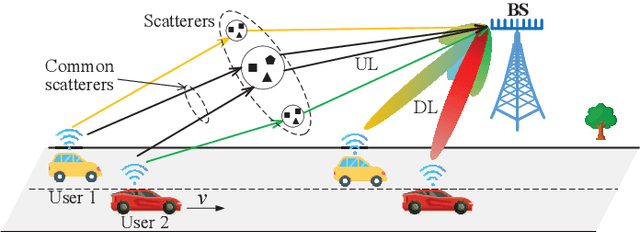
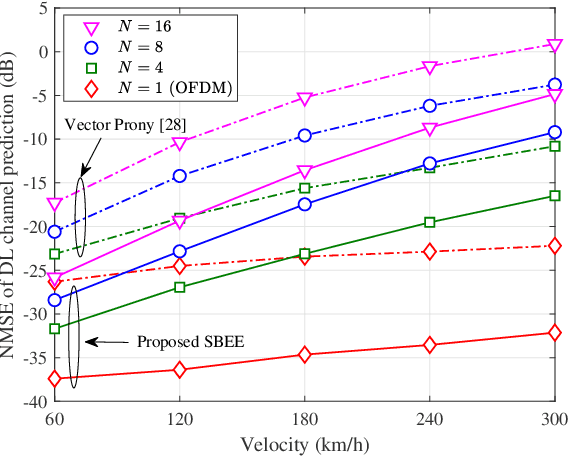
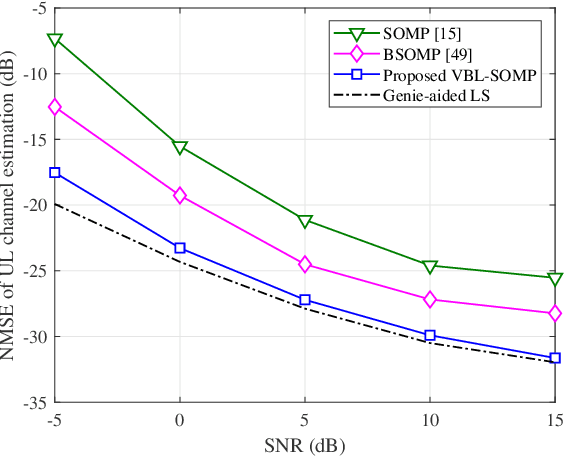
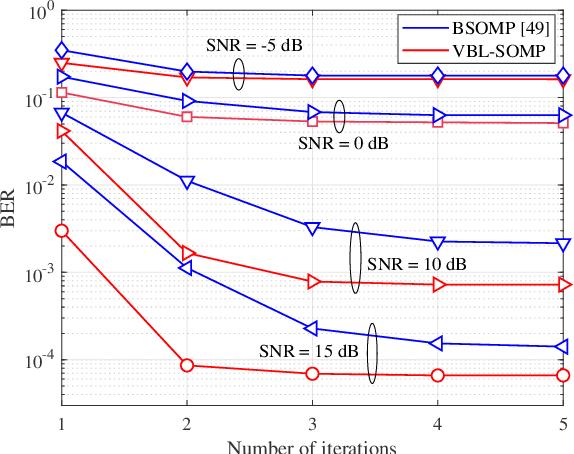
Abstract:Massive multi-input multi-output (MIMO) combined with orthogonal time frequency space (OTFS) modulation has emerged as a promising technique for high-mobility scenarios. However, its performance could be severely degraded due to channel aging caused by user mobility and high processing latency. In this paper, an integrated scheme of uplink (UL) channel estimation and downlink (DL) channel prediction is proposed to alleviate channel aging in time division duplex (TDD) massive MIMO-OTFS systems. Specifically, first, an iterative basis expansion model (BEM) based UL channel estimation scheme is proposed to accurately estimate UL channels with the aid of carefully designed OTFS frame pattern. Then a set of Slepian sequences are used to model the estimated UL channels, and the dynamic Slepian coefficients are fitted by a set of orthogonal polynomials. A channel predictor is derived to predict DL channels by iteratively extrapolating the Slepian coefficients. Simulation results verify that the proposed UL channel estimation and DL channel prediction schemes outperform the existing schemes in terms of normalized mean square error of channel estimation/prediction and DL spectral efficiency, with less pilot overhead.
Joint User Association and Beamforming Design for ISAC Networks with Large Language Models
Jun 05, 2025Abstract:Integrated sensing and communication (ISAC) has been envisioned to play a more important role in future wireless networks. However, the design of ISAC networks is challenging, especially when there are multiple communication and sensing (C\&S) nodes and multiple sensing targets. We investigate a multi-base station (BS) ISAC network in which multiple BSs equipped with multiple antennas simultaneously provide C\&S services for multiple ground communication users (CUs) and targets. To enhance the overall performance of C\&S, we formulate a joint user association (UA) and multi-BS transmit beamforming optimization problem with the objective of maximizing the total sum rate of all CUs while ensuring both the minimum target detection and parameter estimation requirements. To efficiently solve the highly non-convex mixed integer nonlinear programming (MINLP) optimization problem, we propose an alternating optimization (AO)-based algorithm that decomposes the problem into two sub-problems, i.e., UA optimization and multi-BS transmit beamforming optimization. Inspired by large language models (LLMs) for prediction and inference, we propose a unified framework integrating LLMs with convex-based optimization methods. First, we propose a comprehensive design of prompt engineering, including few-shot, chain of thought, and self-reflection techniques to guide LLMs in solving the binary integer programming UA optimization problem. Second, we utilize convex-based optimization methods to handle the non-convex beamforming optimization problem based on fractional programming (FP), majorization minimization (MM), and the alternating direction method of multipliers (ADMM) with an optimized UA from LLMs. Numerical results demonstrate that our proposed LLM-enabled AO-based algorithm achieves fast convergence and near upper-bound performance with the GPT-o1 model, outperforming various benchmark schemes.
Compact Varactor-Integrated RIS for Wideband and Continuously Tunable Beamforming
May 08, 2025Abstract:This letter presents a novel Reconfigurable Intelligent Surface (RIS) that features a low-profile structure, wide operating bandwidth, and continuous phase control. By incorporating a middle patch layer without introducing an additional air gap, the proposed design maintains a thin form factor, while achieving a smooth 310{\deg} phase shift over 10\% bandwidth at 6.1 GHz with excellent reflection. A fabricated 10*10 RIS array exhibits stable performance, enabling precise beam control across a 600 MHz bandwidth. These results highlight the potential of the proposed low-profile, wideband RIS with continuous phase tuning for next-generation wireless communication systems.
A Novel Angle-Delay-Doppler Estimation Scheme for AFDM-ISAC System in Mixed Near-field and Far-field Scenarios
Apr 09, 2025Abstract:The recently proposed multi-chirp waveform, affine frequency division multiplexing (AFDM), is considered as a potential candidate for integrated sensing and communication (ISAC). However, acquiring accurate target sensing parameter information becomes challenging due to fractional delay and Doppler shift occurrence, as well as effects introduced by the coexistence of near-field (NF) and far-field (FF) targets associated with large-scale antenna systems. In this paper, we propose a novel angle-delay-Doppler estimation scheme for AFDM-ISAC system in mixed NF and FF scenarios. Specifically, we model the received ISAC signals as a third-order tensor that admits a low-rank CANDECOMP/PARAFAC (CP) format. By employing the Vandermonde nature of the factor matrix and the spatial smoothing technique, we develop a structured CP decomposition method that guarantees the condition for uniqueness. We further propose a low-complexity estimation scheme to acquire target sensing parameters with fractional values, including angle of arrival/departure (AoA/AoD), delay and Doppler shift accurately. We also derive the Cram\'er-Rao Lower Bound (CRLB) as a benchmark and analyze the complexity of our proposed scheme. Finally, simulation results are provided to demonstrate the effectiveness and superiority of our proposed scheme.
Target Sensing With Off-grid Sparse Bayesian Learning for AFDM-ISAC System
Mar 13, 2025Abstract:The recently proposed multi-chirp waveform, affine frequency division multiplexing (AFDM), is regarded as a prospective candidate for integrated sensing and communication (ISAC) due to its robust performance in high-mobility scenarios and full diversity achievement in doubly dispersive channels. However, the insufficient Doppler resolution caused by limited transmission duration can reduce the accuracy of parameter estimation. In this paper, we propose a new off-grid target parameter estimation scheme to jointly estimate the range and velocity of the targets for AFDM-ISAC system, where the off-grid Doppler components are incorporated to enhance estimation accuracy. Specifically, we form the sensing model as an off-grid sparse signal recovery problem relying on the virtual delay and Doppler grids defined in the discrete affine Fourier (DAF) domain, where the off-grid components are regarded as hyper-parameters for estimation. We also employ the expectation-maximization (EM) technique via a sparse Bayesian learning (SBL) framework to update hyper-parameters iteratively. Simulation results indicate that our proposed off-grid algorithm outperforms existing algorithms in sensing performance and is highly robust to the AFDM-ISAC high-mobility scenario.
Low-Interference Near-Field Multi-User Communication Enabled by Spatially Converging Multi-Mode Vortex Waves
Feb 18, 2025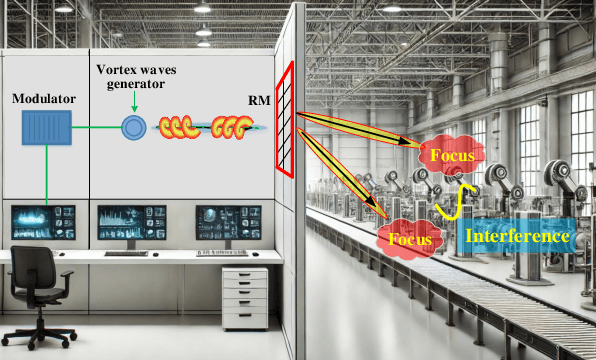
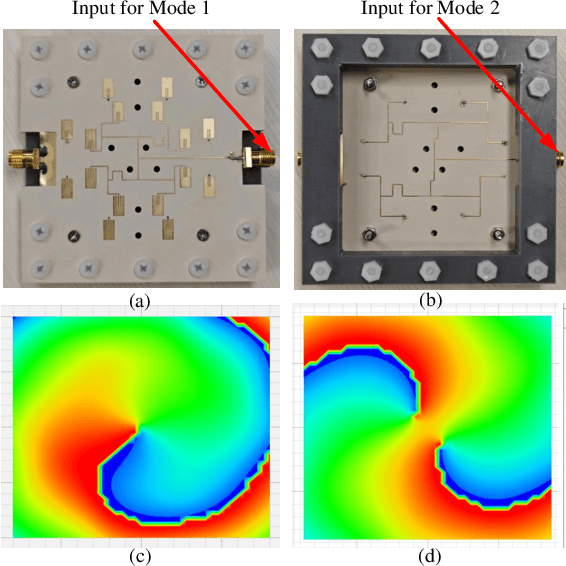
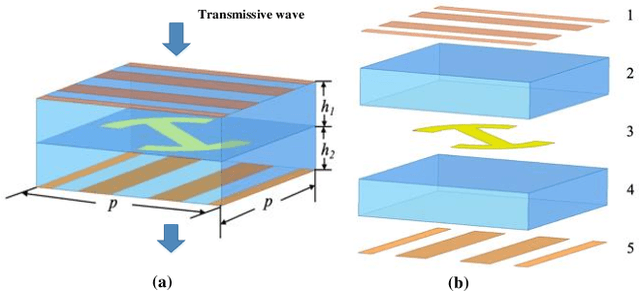
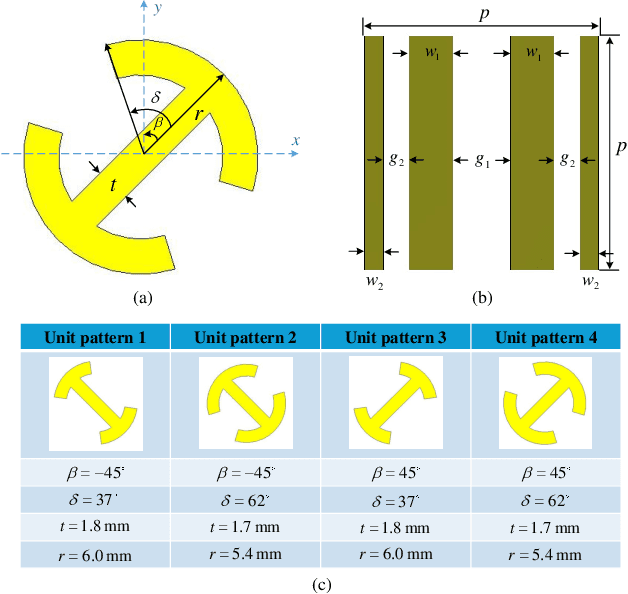
Abstract:This paper proposes a multi-user Spatial Division Multiplexing (SDM) near-field access scheme, inspired by the orthogonal characteristics of multi-mode vortex waves. A Reconfigurable Meta-surface (RM) is ingeniously employed as the gateway for information transmission. This RM not only receives spatially overlapping multiplexed multi-mode vortex beams but also converts them into focused point beams in the near field. Specifically, a multi-port microstrip array method is utilized to generate multiple orthogonal vortex electromagnetic wave modes. Different ports serve as feeding points for baseband signals, allowing independent modulated data to be flexibly loaded onto different modes. After being adjusted by the RM, the vortex electromagnetic waves are converted into energy-focusing point beams, which can be directed to arbitrary 3D positions in the RM's near-field region and received by different users. Since the spatial positions of the point beams are non-overlapping, this approach not only ensures energy concentration but also significantly reduces inter-user interference. Near-field scanning results in a microwave anechoic chamber validate the effectiveness of this method, while real-time communication demonstrations confirm the system's capability for low-interference information multiplexing and transmission in practical scenarios.
Joint Precoder and Reflector Design for RIS-assisted Multi-user OAM Communication Systems
Jan 24, 2025



Abstract:Orbital angular momentum (OAM) can enhance the spectral efficiency by multiplying a set of orthogonal modes on the same frequency channel. To maintain the orthogonal among different OAM modes, perfect alignments between transmitters and receivers are strictly required. However, in multi-user OAM communications, the perfect alignments between the transmitter and all the receivers are impossible. The phase turbulence, caused by misaligned transmitters and receivers, leads to serious inter-mode interference, which greatly degrades the capacity of OAM transmissions. To eliminate the negative effects of phase turbulence and further enhance the transmission capacity, we introduce RIS into the system, and propose a joint precoder and reflector design for reconfigurable intelligent surface (RIS)-assisted multi-user OAM communication systems. Specifically, we propose a three-layer design at the transmitter side, which includes inter-user OAM mode interference cancellation, inter-mode self-interference elimination and the power allocation among different users. By analyzing the characteristics of the overall channels, we are able to give the specific expressions of the precoder designs, which significantly reduce the optimization complexity. We further leverage RIS to guarantee the line-ofsight (LoS) transmissions between the transmitter and users for better sum rate performance. To verify the superiority of the proposed multi-user OAM transmission system, we compare it with traditional MIMO transmission schemes, numerical results have shown that our proposed design can achieve better sum rate performance due to the well-designed orthogonality among different users and OAM modes.
Harnessing Rydberg Atomic Receivers: From Quantum Physics to Wireless Communications
Jan 21, 2025Abstract:The intrinsic integration of Rydberg atomic receivers into wireless communication systems is proposed, by harnessing the principles of quantum physics in wireless communications. More particularly, we conceive a pair of Rydberg atomic receivers, one incorporates a local oscillator (LO), referred to as an LO-dressed receiver, while the other operates without an LO and is termed an LO-free receiver. The appropriate wireless model is developed for each configuration, elaborating on the receiver's responses to the radio frequency (RF) signal, on the potential noise sources, and on the system performance. Next, we investigate the association distortion effects that might occur, specifically demonstrating the boundaries of linear dynamic regions, which provides critical insights into its practical implementations in wireless systems. Extensive simulation results are provided for characterizing the performance of wireless systems, harnessing this pair of Rydberg atomic receivers. Our results demonstrate that they deliver complementary benefits: LO-free systems excel in proximity operations, while LO-dressed systems are eminently suitable for long-distance sensing at extremely low power levels. More specifically, LO-dressed systems achieve a significant signal-to-noise ratio (SNR) gain of approximately 44 dB over conventional RF receivers, exhibiting an effective coverage range extension over conventional RF receivers by a factor of 150. Furthermore, LO-dressed systems support higher-order quadrature amplitude modulation (QAM) at reduced symbol error rates (SER) compared to conventional RF receivers, hence significantly enhancing wireless communication performance.
 Add to Chrome
Add to Chrome Add to Firefox
Add to Firefox Add to Edge
Add to Edge